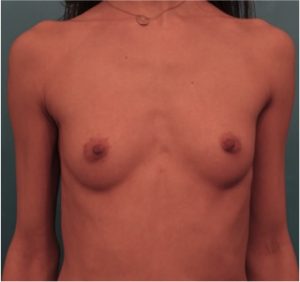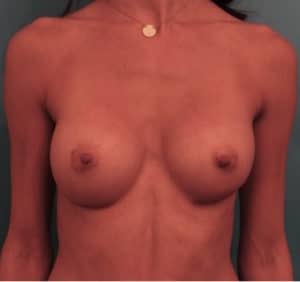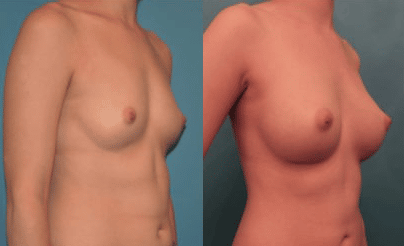Breast Augmentation NYC | Breast Implants Manhattan – Dr. Shridharani
Top Breast Augmentation Expert in NYC
Breast augmentation surgery has been the most commonly performed cosmetic surgical procedure since 2006, with upwards of 300,000 patients partaking in this surgery every year.
Breast Augmentation with Dr. Shridharani
Also referred to as augmentation mammoplasty, breast augmentation is a procedure that increases the size of the breasts using either silicone or saline implants. Dr Shridharani is also able to utilize fat transfer, or using the patient’s own fat, to perform the surgery.


During your initial consultation, Dr. Shridharani will discuss with you your goals concerning your ideal breast size and shape in order to recommend which type of implant is best suited for you. When it is time for surgery, Dr. Shridharani measures the breasts of the patient with an inflatable implant sizer in order to precisely determine the implant size for the patient. If asymmetry is an issue, implant sizes may vary for each breast.
Watch Dr. Shridharani Perform a “No Touch” Breast Augmentation
Types of Breast Implants: Silicone Gel vs. Saline
Silicone breast implants: Silicone implants are aptly named as they are filled with silicone gel in order to give the breasts a natural feel. If the implant were to break or rupture, the implant will not collapse and the gel could potentially remain inside the implant. This type of implant is FDA-approved for women 22 years of age or older. This type of implant is the most commonly used type of breast implant around the world, as they not only have the most natural feel but also last longer than saline implants.
Saline breast implants: The other most commonly used type of breast augmentation implant, saline implants are filled with sterile saline (saltwater). If the implant pops or ruptures, the saline would be absorbed and expelled naturally from the body. This type of implant provides a uniform shape and are FDA-approved for women 18 years of age or older.
How Are Breast Implant Sized?
Many individuals tend to assume that implants are sized in the same way as bra cup sizes, but this is not accurate. Implants are sized in accordance with the amount of material (silicone or saline), that fills up the implant. This is measured in cubic centimeters (i.e. 300 cc implant size).
Breast Implant Shapes
Breast implant shapes can be either round or anatomic also known as the “teardrop” shape.
Round breast implants: This breast implant shape leads to a fuller appearance in comparison to form-stable implants, and generate more projection. Round implants will vary in projection in accordance with the individual undergoing breast augmentation surgery. Since the implant is the same shape in all dimensions, there is no worry about the implant rotating.
Anatomic or “gummy bear” breast implants: Anatomic implants, also known as “gummy bear” or form-stable implants, keep their shape even if the implant shell is damaged or broken. The silicone gel that resides in this type of implant is more cohesive and viscous than that of traditional silicone implants. These implants have a thicker consistency, and are firmer than traditional implants. However, they are considered to be less likely to break.
Gummy bear implants are generally shaped more like a natural breast instead of simply round. They are tapered towards the top and have more projection towards the bottom. If the implant were to rotate, there would be a definite risk of an unnatural appearance of the breast. This means that this type of implant could require a revision in order to correct the orientation and position of the implants. Anatomic implants may require a longer incision in the skin.
Smooth and Textured Breast Implants
Smooth breast implants: This implant type has the softest feel. Smooth implants move within the implant pocket, giving the breasts a more natural movement. Because of their soft nature, soft implants may produce visible rippling of the skin over a period of many years.
Textured breast implants: This implant type develops healthy scar tissue that attaches itself to the implant, ensuring that the implant will not reposition on its own. Due to this there is less natural movement associated with this implant type. Research shows that because of these textures, implants have the potential to exhibit less risk of a scar capsule.
Are Silicone Gel Implants Safe?
Of course! Extensive and detailed population studies have failed to express any correlation between autoimmune disease and silicone breast implants. The moratorium on silicone gel implants was lifted in 2006, leading to the return of silicone breast implants in the United States. Recent silicone implants include a barrier layer to combat the bleeding or leaking of silicone that sometimes would occur in older implants. Silicone implants last approximately 10 years, and have a rupture rate of approximately 1-2% each year.
Breast Implant Incisions and Placement
Implants can potentially be inserted through a few different incision sites, the most common of which are the periareolar region (around the areola of the nipple) or inframammary (under the fold of the breast). Other less utilized options include the underarm or the belly button. Dr. Shridharani will be able to recommend the best incision for the patient.
Implants are also able to be placed under the muscle or in the fascia above the muscle. Again, this placement varies from one patient to another. Patients with less breast tissue will generally have the implant placed under the muscle for a more natural appearance. However, a patient with more breast tissue to begin with may have their implant above the muscle.
- Areola — This type of incision is placed outside of the areola, the darkly pigmented skin that surrounds the nipple. This incision is well hidden upon healing from the surgery. Implants can be placed either over or under the pectoral muscle. Unfortunately, this incision location restricts the size of the silicone implants, as they are filled prior to insertion and will need to fit through the incision. There is also a risk of nipple sensation loss, as well as the ability to breastfeed in the future.
- Inframammary crease — This incision is done along the crease below the breast. Generally, the surgeon will make the incision on the crease in order to hide the incision under a typical bikini or lingerie. The surgeon has the best view and control with this incision, and the implants can be placed wither above the chest muscle or below through this crease. The downside is that there is more visible scarring with this incision than with others. Muscle also needs to be cut during this incision if the implant goes below the muscle, which will lengthen recovery.
- Transaxillary — In this case, the incision is made vertically in the armpit area. The surgeon can use an endoscope to give themselves a better view of the breast pocket during surgery. There is no scarring of the breasts with this incision, and the scarring in the armpit area generally becomes almost invisible over time. Placing the implants beneath the pectoral muscle does not require any muscle cutting in this type of incision, and implants don’t come in contact with the milk ducts. This avoids any chance of bacteria that causes inflammation and/or capsular contracture that could take place in the other incision types. This is the best type of incision for larger implants. There can be rubbing of the implant against the skin during insertion, which can cause some bacterial complications. No deodorant can be worn for a few weeks after surgery with this incision.
- Transumbilical — Implants are inserted through the belly button in this the rarest type of incision. An endoscope is used here to provide an internal view for the surgeon. There is almost no scarring because the incision occurs inside the belly button, and only one incision is required. Recovery is generally the easiest in this method since it is the least invasive. There is also obviously no scarring to the breast. Revision or implant replacement generally cannot be done through the same incision technique, and silicone breast implants cannot be placed during this method. Additionally, bleeding is a bit harder to control, and there is a slightly higher risk of damage to the implant during this incision and placement technique.
Dr. Shridharani will review all of this information with you during your consultation with him at the office in New York City.

The patient had a 270 cc smooth, round, moderate plus profile silicone gel implant placed on the right side and a 210 cc smooth, round, moderate plus profile silicone gel implant placed on the left side. Both implants were placed underneath the muscle (pectoralis major) through an inframammary incision approach (underside of the breast). She is pictured here 1 week prior to surgery and 9 months after her procedure.
VIEW BREAST AUGMENTATION (IMPLANTS) GALLERY
How Long Does a Breast Augmentation Procedure Take?
Every patient is different, so the time of the procedure will differ from one patient to the next. Generally, you can expect this type of surgery to last a few hours.
Watch Dr. Shridharani Perform A Breast Augmentation with Fat Transfer
Breast Augmentation Recovery
The first few days after undergoing your breast augmentation in NYC will most likely be met with some discomfort, as is the case with most surgeries. Many patients however do not even need or use their prescribed medications for pain, and those that do generally only use it for the first week or less. Recovery varies depending on incision location, implant size, and whether the implants are above or below the pectoral muscle.
Tightness in the chest is a perfectly normal feeling during this time, as the tissue will be stretched as the implants settle into place. Upon first view of your new breasts, they may appear too high on the chest, but this is a normal feeling as well, as implants will be brought down when they settle.
After clearing your anesthesia you will return home with a medical compression bra overtop of your incision bandages, which will aid in minimizing swelling and keeping any strain off of your stitches. This will be worn for all of your initial recovery.
In general, patients return to work four or five days after surgery, though implants placed under the muscle may require a full week. Non-impact activity can commence in a week or so, but exercise involving impact should be held off for at least a month. Certain upper body exercises can be resumed in six weeks or so, and you should refrain from lifting anything above your head for six weeks as well.
Will I Need to Wear a Special Bra After Breast Augmentation Surgery?
The aforementioned medical bra will need to be worn 24 hours a day for the first three to four weeks, and perhaps longer depending on your incision location. While not incredibly comfortable, these bras are vital to the healing process.
Possible Side Effects After Breast Augmentation
As with any major surgery, breast surgery has risks involved. These risks include bleeding, infection, anesthesia reactions, and so on. Some specific risks included in breast augmentation surgery include loss of sensation in the nipple or breast, loss of breastfeeding ability, implant rupture or leakage, and improper positioning.
Capsular contracture is the biggest risk with this type of surgery. The body builds scar tissue around the implants naturally, but if this tissue builds too aggressively it can cause the implants to feel overly hard or firm, and can even deform the implants. If this happens, they will need to be replaced and the excess scar tissue will need to be removed.
Initially, there were suspicions of a link between breast implants and autoimmune diseases, countless studies have shown that this is not the case.
Will I Need to Get my Implants Replaced During my Lifetime?
As of now, there are no implants that last forever, so they will have to be replaced at the end of their natural lifespan. Implant manufacturers generally provide warranties for up to 10 years. However, some implants can last 6 to 7 years while others may last 20. Eventually, at the end of their lifespan, they will weaken and rupture, and revision surgery will be required to replace old implants with new ones.
That being the case, a woman in her 30s can expect to replace her implants anywhere from 2 to 5 times in her lifetime. Implants are becoming more durable with new discoveries in cosmetic surgeries but for now, this estimate is generally a good rule of thumb.
When replaced, depending on the type of incision involved in the first surgery, your surgeon may be able to enter through the initial incision, which will help in minimizing any additional scarring.
Patient Testimonial
At Luxurgery success is measured not only by surgical results but by patient care and satisfaction. We take great pride in being closely involved in our patients’ journeys to ensure optimal outcomes.
We are honored to have our lovely patient bravely share her experience with us and address all her pre-op concerns. Blinda came in with a desire to undergo a breast augmentation after years of consideration. Now, she’s just 12 DAYS out from her procedure with Dr. Shridharani and recovering wonderfully! Listen carefully to her describe her journey.
Schedule a Consultation for Breast Augmentation in NYC
If you want to learn more about breast augmentation surgery and find out if you are a good candidate, call today at (212) 508-0000 and schedule a consultation with board certified NYC Plastic Surgeon, Dr Shridharani.
Breast Augmentation FAQ’s
My patients have the ability to have their procedures performed at my office or at area hospitals and “surgicenters” in New York City. My operating room and facility have certification and accreditation by the American Association for Accreditation of Ambulatory Surgery Facilities (AAAASF). Our team provides patients with the option of having their procedure performed in the safety, convenience, and comfort of our office/facility.
Breast augmentation surgery is the most commonly sought after cosmetic surgery procedure in the United States. Like any surgical procedure, there is some discomfort involved with having an incision on your body. One of the biggest factors in having breast augmentation is implant placement. Many surgeons opt for placing the implant “below the muscle,” which often entails more pain. Nonetheless, patients liken the pain the first few days to having performed “a lot” of push-ups and then progressively less pain as the week continues. A good regimen of anti-inflammatory medications with long-acting local anesthetics paired with good surgical technique leads most patients to be off narcotic pain medication by 2-3 days after surgery.

